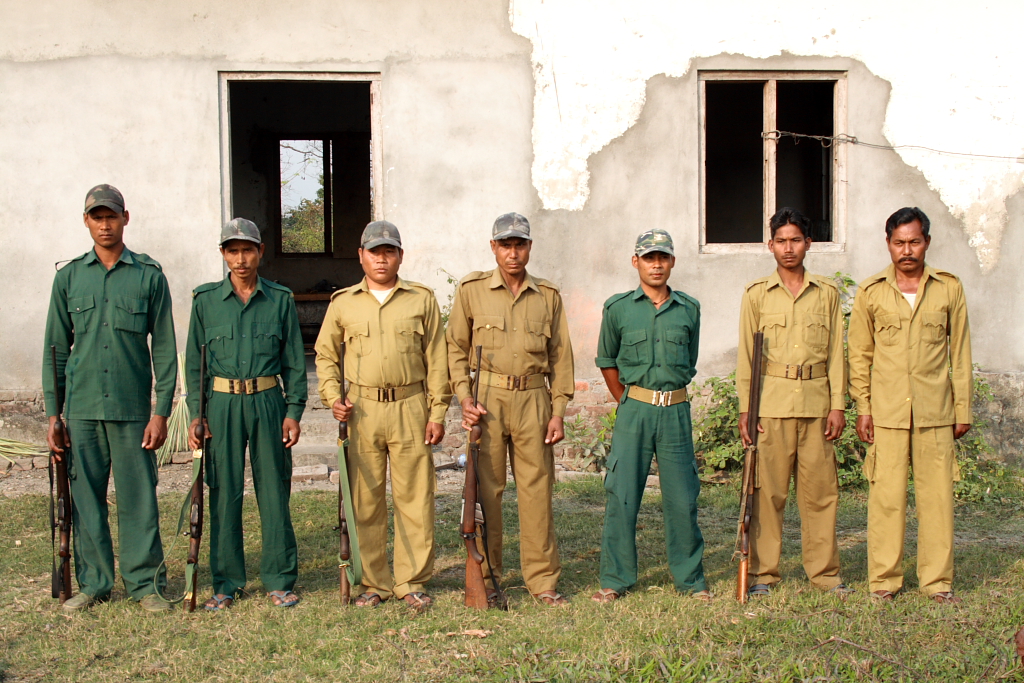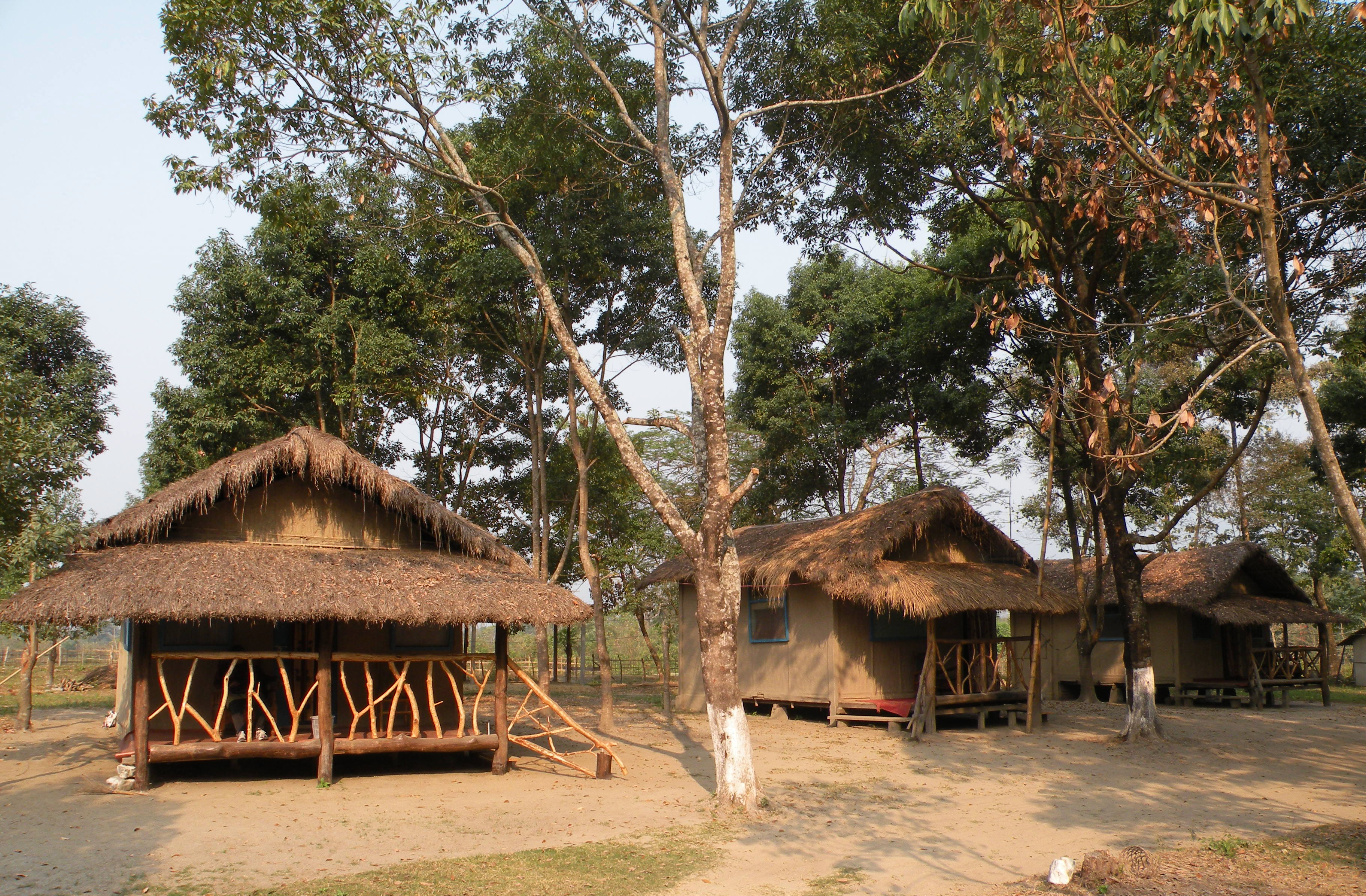The seeds of this organization germinated from the violent past of the Bodo movement. For many years the Bodos had been suppressed by the state government, forcing them to start a mass political movement for a separate state. This political agitation came to a halt in 1993 after the signing of a tripartite agreement between the Bodo leaders, Central government and State government. But a couple of years after signing the accord, frustrated by the failure of the government to implement the agreement, the Bodos grouped together to form an armed outfit under the banner of Bodo Liberation Tigers to press for their demands.
This was the dark period during which Manas was depleted of its resources. Since the southern boundary of Manas spans across the entire Bodo dominated territory, there was vast deforestation. Due to the complete breakdown of the law and order situation in and around Manas, the locals often took shelter in the forest to escape the atrocities of the policing forces. Taking advantage of this lawless situation, some unscrupulous businessmen started forming organized groups for poaching and felling, which got free access to the park. Some groups of poachers made sporadic attacks on the forest offices causing destruction to most of the protection camps in the park . This grim situation compelled the forest guards to abandon almost all the protection camps. The situation was so perilous that UNESCO declared it as a world heritage site in danger.
Even during these troubled times a small group of Bodo youth from the Chapaguri Koklabari Anchalik Committee in the Koklabari area went ahead with their crusade of conserving Manas. They conducted motivation campaigns at selected areas where tree felling and poaching were rampant, asking the local villagers to refrain from their destructive activities by seeking other means of livelihood. At length, the student leaders of the committee put forward a crucial proposal for the protection of Manas while establishing it as an international tourist destination. The committee members urged their top leaders to place the issue of conserving Manas National Park, making it an international tourists destination, at the negotiating table while the leaders were exercising cease-fire with the Central and State governments. This event marked the beginning of the transition of the Bodo mindset from terrorism to tourism.
In 2003 when the Bodo Accord for creating Bodoland Territorial Areas Districts was finally signed, the issue of restoring Manas National Park whilst making it an international tourist spot was incorporated as one of the special packages within it. Enthused by this development, some people from the Koklabari area came up with the idea of creating a bird watching centre cum tourist spot. Thus in December 2003 Manas Maozigendri Ecotourism Society (MMES) was born with the objective of conserving Manas National Park as also to restore it back to its former glory.
The initial two years were a testing period for the organization, due to limited funding coupled with stiff resistance from the local people. To start with, awareness campaigns denouncing poaching and logging were conducted in some of the fringe villages. The members of the Society personally went and spoke to the families of hardened poachers, explaining to them the ills of the profession. As a result a group of fifty poachers succumbed to the social pressure, giving up their arms to work instead as conservation volunteers with the Society. With the help of these poachers, a survey of the forest was conducted so as to locate the areas where there was maximum poaching and logging. After identifying these areas, patrolling was commenced with volunteers. In the beginning the guards faced lots of hardship as there were no permanent protection camps in the forest. There were instances when just five or six of the volunteers were attacked by a group of fifty loggers, despite which they overpowered the loggers. The society did not even have money to pay remuneration to the guards, but their rations were taken care of. Seeing this level of dedication and commitment, the then park director Mr. Abhijit Rabha gave his complete support to the society, assisting in every possible way. The forest department along with the society joined forces to slowly eradicate all the poaching camps from within the park.

From poachers to protectors
Over the years MMES has increased the gamut of their activities manifold. Currently there are 11 protection camps where the conservation guards stay throughout the year to patrol the national park, covering an area of more than 300 sq. kilometers. To provide logistical support to these camps MMES has built a network of roads extending more than 60 kilometers. Since the road network forms the backbone for the conservation activities, they are regularly maintained. The conservation guards patrol the forest on a daily basis to ensure that there are no illegal activities. Oftentimes they go deep into the forest for two to three days, camping in make shift shelters.
Understanding the importance that the grasslands play in the ecosystem, the MMES annually maintain the grasslands by burning them in a controlled way. Their consistent efforts have paid off as today there is neither any poaching nor logging happening in the areas being patrolled by them. Wildlife populations have surged back as have the migratory birds. In fact, the resurgence of the elephant population is creating a man- animal conflict where the elephants often damage the houses of villagers. In such cases, MMES is paying the affected villagers compensation to repair the house. Monitoring of endangered species has been reinstated with the assistance of outside researchers. A conservation and monitoring centre of the critically endangered Bengal Florican has been set up in the Koklabari farm. Awareness campaigns are regularly held in fringe villages for educating the people on the importance of conserving the rich biodiversity of Manas. School children are taught to appreciate their rich inheritance by taking them on excursions in the national park.

Manas Jungle Camp
MMES’s long cherished dream to make Manas into an international tourist destination was accomplished in 2005 when the first foreign tourist stayed at their Jungle camp. This was thanks to the initiative by Help Tourism who spent a lot of time,effort and money in working with MMES for developing the tourism capacity over here. They conducted many trainings and workshops for the MMES boys to cater to the needs of the tourists. Besides Help Tourism also put in a great deal of effort on the conservation front, by conducting many surveys for wildlife inventory. The Jungle camp has five traditional huts made of mud and bamboo which are equipped with modern facilities to accommodate tourists. Open jeep safaris, bird watching, jungle trails, rafting on the Manas, cultural trails are some of the options which MMES offers to tourists depending on their interest. Their idea behind initiating tourism service has been, both complimentary and supplementary to their conservation activities. As a community, they want to show the world that Manas has regained its past beauty and is no more an endangered world heritage site. The greater challenge confronting the MMES has been to shed the perception of being an insurgent community, a view which is still prevalent among many outsiders. The other equally important task on hand has been to fund their conservation activities. With very limited sources of revenue for their conservation activities, tourism has been providing them with the much needed funds.
Taking encouragement from the excellent work being done by MMES in the Koklabari area, six other NGOs with a similar model have started operating in other areas in Manas. Visibility about their tremendous effort will play an important role in the long term sustainability of their work. What Manas needs today is for us to support and appreciate this phenomenal community initiative, and to assist in dispelling the false notion of the Bodos as a gun-toting community because they are truly a warm and cultured community, their hospitality well worth experiencing.

Pingback: The Maozigendri experience « Walking a dream
learning
Congratulations for wonderfful work done. Please send detailed map of the area where your social work is on. This is for tourist information.
Prakash